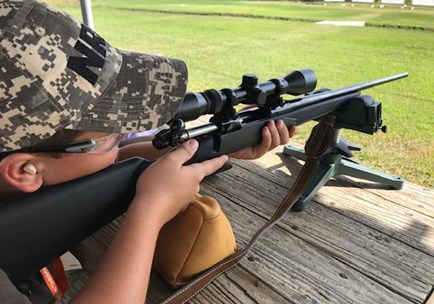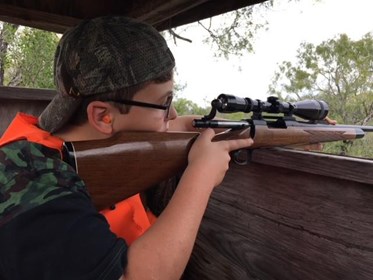5 Ways to Stabilize your Rifle When Shooting
There are various methods and products to help keep your steady as you ready your rifle to take a shot. Here are the basics.
by HEIDI LYN RAO posted on March 22, 2023
NEWS, HOW-TO, TIPS & TACTICS, HUNTING, GEAR, FIREARMS
Support NRA Women DONATE
Shooting from the benchrest position is the most common position rifle shooters use. This is the first position taught in the NRA Basic Rifle course. Shooting from the benchrest position provides for the most stability when sighting in your rifle, while target shooting, or when hunting. When you are sitting at the benchrest, you have at least five points of contact helping stabilize the firearm while you are shooting: your feet, your rear end, your elbows, and the forearm of your rifle.

5 Ways to Stabilize your Rifle When Shooting – NRA Women.com
To assume the benchrest position, sit behind the bench facing the target. Rest both elbows on the bench and grasp the stock wrist with your firing hand. Place the butt of the stock against your shoulder so that the rifle sights are at eye level, while keeping your head erect. Position the rifle against your face and shoulder so that your dominant eye can look through the sights comfortably and naturally.

Shooting Bags
Shooting bags are the most common type of support for rifles while on the benchrest. Simple shooting bags are square or rectangle, and are made of cloth or vinyl, and usually filled with sand. Even items found in your kitchen pantry can be used for shooting bags. I have seen individuals at the range use bags of rice or beans as support. I have also seen individuals that reload use bags of shot that is used in shotshell reloading, as shooting bags.
Numerous manufacturers make specialized shooting bags that come in many different shapes. Some of these bags have a “V” filled with the same material as the rest of the bag sewn into the top to snugly hold the rifle. Others have filled protrusions sticking out of the bag, so the unit can be turned to achieve the correct height for shooting. There are also bags made to support the front of the rifle, and bags made to support the stock of the firearm.

Shooting Sticks
Shooting sticks are becoming more popular among shooters, especially hunters. Shooting sticks can come in monopods, bipods, and tripods. These devices can be as simple as one-piece bamboo poles. Single poles can be used as monopods, while bipods and tripods can be bound with a piece of latigo or heavy rubber band.
Many of the newer shooting sticks that are available on the market are relatively “high tech” compared to the simple bamboo poles. Modern shooting sticks can be made with strong, lightweight carbon fiber legs that telescope to adjust the length and are equipped with friction locks to secure the proper height in place. Some even have triggers attached to the pole, that the shooter can activate while holding the rifle in place, to raise and lower the pole so the gun achieves the correct sight picture in relation to the target.
Attached Bi-Pods
Attached bipods are mounted on the fore end of the rifle and usually have two legs that fold up when not in use. Some of these devices are mounted permanently on the fore end of the rifle. Some manufacturers make removeable bipods that can easily be installed when needed and removed when not needed.
Attached bipods usually mount to the front sling stud and fold up along the fore end when not in use. When needed, you would simply fold the spring-loaded legs down, perpendicular to the firearm. The legs of the bipod are then adjusted to the desired height. Some legs have rubber feet at the end to prevent the firearm from sliding while you are taking aim or firing. Others have legs with points to secure it into the ground when hunting.

Arm Rest Standing Position
The Arm Rest Standing Position is accomplished by supporting your rifle with your non-dominate hand while bracing the gun with the elbow on the same arm, against your body. This provides a very stable platform for the rifle when shooting. The Arm Rest Standing Position is one of the shooting positions taught in the NRA Basic Rifle Class. This is the preferred position for competition shooters.
To get into the Arm Rest Standing Position, start with your feet shoulder width apart and your body at a right angle to the target. With your body weight distributed equally on both feet, bend your body backwards at the waist, away from the rifle. While your head is erect, The upper part of support arm rests on side or hip. Your support hand is placed under the fore-end, supporting the weight of the rifle, with a straight wrist. The firing hand grasps the stock wrist or pistol grip, with index finger extended above the trigger, along the frame.

Situational Supports
Situational supports are anything present that can be used to stabilize a firearm for shooting. While hunting, the most common situational support is the windowsill of a hunting blind. Almost every deer hunter, at one time or another, has eased their rifle out the shooting window of a blind, resting the fore end of the gun on the windowsill and lining up the sights, as a deer cautiously steps into the clearing.
Other situational supports include fence rails, fallen tree trunks, boulders, or anything else present when a target presents itself. It is important to make sure that whatever situational support you use is sturdy and safe. For example, you would not want to use a weak or rotten limb that would break under the weight of the rifle when it is rested on top of it. A dropped rifle can lead to an accidental discharge, that could damage a firearm and/or cause serious bodily injury or death.
Other items you have with you such as extra clothing and your day pack, can also provide support for a rifle. It is not uncommon for hunters to roll up a sweatshirt, jacket, or maneuver their backpack to provide for the proper height to align sights on a target that may be across the field. Whatever support that is used, make sure it is appropriate and stable.
